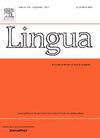从声音上看,潇洒比笨拙快:英语动作动词的语速符号
IF 1.3
3区 文学
0 LANGUAGE & LINGUISTICS
引用次数: 0
摘要
心理学实验已经建立了快慢语速与我们感知中的各种音素或语音特征之间的声音符号关联。这些关联偶尔也会在“快”和“慢”的跨语言词汇中得到证实。本研究旨在确定语速符号是否广泛存在于英语动作动词(如dash, lumber)中,这些词被认为更有可能表现出语速符号。使用评级问卷来获得每个动词的隐含速度。一个极端梯度提升(XGBoost)模型显示,音素频率本身可以解释14.36%沿速度维度的语义变化,这是一个适度但真实的影响。音素/m/、/ h /、/t / h /和/ h /成为速度等级的重要预测指标,其中/m/和/ h /与慢有关,而/ h /和/t / h /与快有关。我们的发现为自然语言中声音象征的存在提供了进一步的证据。此外,英语的音义匹配模式与之前的行为任务所确定的模式基本一致,这表明我们的语言构建方式受到说话者对语音的感知的影响,或者至少与之一致。本文还讨论了语速符号的可能机制及其对语言进化和电话主位概念的影响。本文章由计算机程序翻译,如有差异,请以英文原文为准。
Dashing is faster than lumbering by sound: Speed sound symbolism in English motion verbs
Psychological experiments have established sound symbolic associations between fast/slow speed and various phonemes or phonetic features in our perception. These associations were also occasionally attested cross-linguistically in words for “fast” and “slow”. This study aims to determine whether speed sound symbolism resides extensively in English motion verbs (e.g., dash, lumber), words presumed to be more likely to exhibit speed sound symbolism. A rating questionnaire was used to obtain each verb’s implied speed. An extreme gradient boosting (XGBoost) model revealed that phoneme frequency alone can account for 14.36% of semantic variation along the speed dimension, which is a modest but genuine effect. Phonemes /m/, /ʃ/, /t͡ʃ/ and /ɑ/ emerged as important predictors of speed ratings, with /m/ and /ɑ/ associated with slowness while /ʃ/ and /t͡ʃ/ with fastness. Our findings provided further evidence for the existence of sound symbolism in natural languages. Moreover, the sound-and-meaning matching patterns in English generally agree with patterns identified by previous behavioral tasks, suggesting that the way our language is constructed is affected by, or at least coincides with, speakers’ perception of speech sounds. The possible mechanisms underlying speed sound symbolism and its implications on language evolution and the concept of phonestheme are also discussed.
求助全文
通过发布文献求助,成功后即可免费获取论文全文。
去求助
来源期刊

Lingua
Multiple-
CiteScore
2.50
自引率
9.10%
发文量
93
审稿时长
24 weeks
期刊介绍:
Lingua publishes papers of any length, if justified, as well as review articles surveying developments in the various fields of linguistics, and occasional discussions. A considerable number of pages in each issue are devoted to critical book reviews. Lingua also publishes Lingua Franca articles consisting of provocative exchanges expressing strong opinions on central topics in linguistics; The Decade In articles which are educational articles offering the nonspecialist linguist an overview of a given area of study; and Taking up the Gauntlet special issues composed of a set number of papers examining one set of data and exploring whose theory offers the most insight with a minimal set of assumptions and a maximum of arguments.
 求助内容:
求助内容: 应助结果提醒方式:
应助结果提醒方式:


